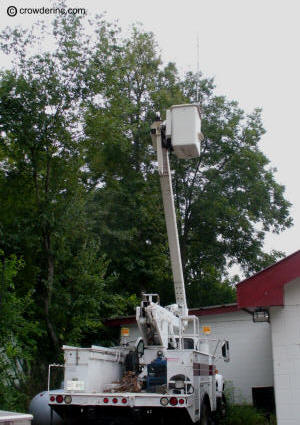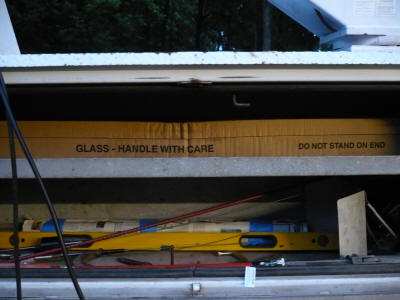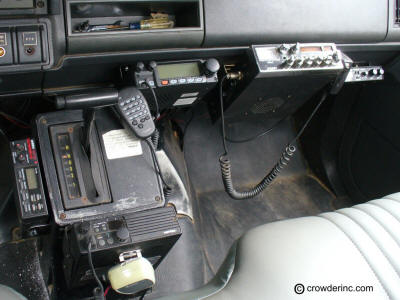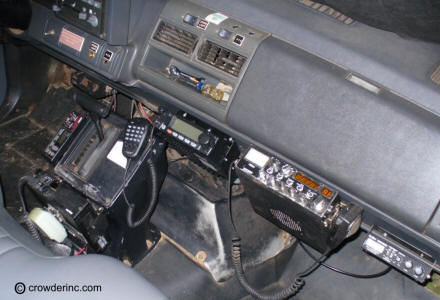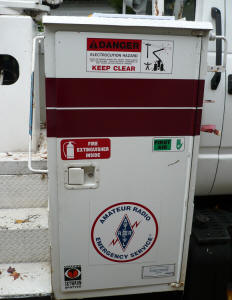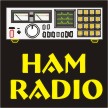1997 GMC TOPKICK
I am in the process of converting the Top Kick into a dual purpose work vehicle and emcomm bug out vehicle. This truck is almost a perfect platform for a communications vehicle. It has a Caterpillar 3116 diesel engine and a Allison automatic transmission. This is the biggest truck you can buy without needing a commercial drivers license. Now comes the kicker... The truck is equipped with a High Ranger bucket along with an extendable jib and winch. Fully raised it has a "working height" of 43 feet to the bottom of the bucket. Its the perfect platform for mounting antennas.
THE ANTENNA FARM ON THE 1997 TOPKICK
THE BOX IN THE CENTER PHOTO CONTAINS MANY DIFFERENT ANTENNAS
The bug out emcomm truck has a virtual antenna farm sprouting from it at present with more hard mounted mobile, rotatable directional and vertical base antennas planned for the future. It currently has three dual band VHF/UHF antennas, a glass mount wide band scanner antenna, a 10 meter mobile and an 11 meter mobile mounted at all times. In the antenna compartment there are over a dozen antennas that can be attached to the bucket or other locations and raised to a 50 foot height to their base. Currently this kit is comprised of a Cushcraft omnidirectional vertical 2 meter base antenna, a 2 meter directional antenna, a 70 centimeter directional antenna, two omnidirectional UHF antennas, a VHF/UHF dipole, a Radio Wavze HF dipole and an assortment of extra mobile antennas.
The multiband dipole is attached at its center to the jib on the bucket and then the ends are staked out using a couple of fiberglass extendable poles in an inverted V configuration. One of the mobile dual band antennas terminates into a SMC connector with a BNC adapter. This gives us the option of running one of the handi-talkies off of a high gain antenna for better transmission and reception range. Of course I also have a huge collection of ready made coax cables, power cables and mounting devices to reconfigure the antennas in the field to adapt to different needs. The truck also has two SWR meters dedicated to it in the event we have to start making field modifications.
1997 GMC TOPKICK BUCKET TRUCK WITH
YAESU 2800, GALAXY 959, VERTEX STANDARD, ICOM T90A & UNIDEN SCANNER

KENWOOD 480 SAT W/COMPUTER FOR DIGITAL MODES,
EXTRA RADIOS IN RADIO COMPARTMENT AND EXTRA H.T.'S
While the Yaesu FT-2800M may seem to not have a lot going for it when looking at the frequency coverage specifications, this radio totally rocks. Its military spec construction, WIRES capability and 65 watt output make for a great mono-band 2 meter radio. This radio has more memory locations than you could want on a single band radio and the full access to the controls right on the microphone make this a favorite radio. The 65 watt output really reaches out and touches repeaters, especially when it gets connected to the Cushcraft base antenna at its full height of over 50 feet.
The Kenwood 480SAT is the total bomb for emcomm work. The integral tuner combined with the dipole at its full height makes easy work of the West Coast and DX contacts. It links up to a computer for digital modes with the greatest of ease.
Also in this truck I have a Galaxy 959, 11 meter citizens band radio for when I am on the road. This is a fully featured 11 meter rig with frequency counter and larger power/SWR meter. Also for when the truck gets deployed, I have two additional citizens band 11 meter rigs in one of the tool boxes to be used to monitor for distress calls or to coordinate with non licensed operators during an emergency call out.
The UHF communications are handled by three bullet proof Vertex (Yaesu) radios. These were originally a business band radio that got rolled into the amateur community when the company using them switched to cell phones. The one installed in the cab is programmed for local UHF repeaters. One of the Vertex rigs in the communications compartment is programmed for GMRS frequencies and FMRS frequencies. These two are used to listen for distress calls from the public and to coordinate with non licensed rescue workers using radios that don't require an amateur license.
The Uniden Bearcat scanner still works for scanning most highway patrol systems and many local law enforcement radio traffic. Also in the communications compartment are six FMRS/GMRS radios that are available to hand out to non licensed rescue workers that may show up without a radio. There are also two very durable Radio Shack two meter handi-talkies to be put into service as needed.
THE BACK UP BATTERY SYSTEM
Having lots of radios to deploy during an emergency is a great thing but they are useless without power to run them. This truck is equipped with a 8,000 watt generator but it is a tad noisy which could make verbal communications a tad problematic. There is also a small 1,850 watt generator stowed in one of the tool boxes that can be carried far enough away from the communications center to reduce this problem but setting it up, pulling the necessary drop cords, then distributing the power through regulated supplies takes time.
My solution to aid in being prepared for rapid deployment and always being sure that I have quick and reliable power available is the time proven battery bank. The truck has two large 1,200 CCA diesel truck batteries that power its engine requirements and the in-cab radios. To provide immediate power to the radios in the bug out kit, I have three 850 CCA batteries in weather proof boxes. They are wired in series to share the load equally and insure that one isn't drained too quickly while the other may not be loaded enough. Having a total five large batteries at the ready gives quite a bit of talk time before we have to worry about turning on the generators.
To be sure they always have a charge I have two solar panels that keep them continuously charged. One is a 350 milliamp panel and the other is a 500 milliamp panel. The two combined provide .85 amps and 12 watts at 14 volts during full sun. I also have a 1.5 amp float charger wired into the system that can renew the charge to the batteries when standard 117 volt AC electricity is available either from a wall socket or one of the trucks generators. They can also be recharged from the vehicles alternator. This three tiered charging system gives lots of flexibility in keeping the radios powered.
ADDITIONAL INFORMATION
To make this truck official at a scene and not look like a rolling billboard for my business we have a full set of magnetic signs stuck to the inside of the bed that are a mix of ARES logos, ARRL logos and other verbiage. These are sized to fit over my company markings and inform anyone that is within site that this is an official emcomm vehicle. The truck is also equipped with vertical rescue equipment, chain saw, orange cones, reflective vests, hard hats, rain coats, emergency lighting, generators, welder, hand tools, electrical repair supplies, basic HAZMAT protection supplies, and much more. Not only can this truck be used for emcomm but it is ready for hazard mitigation and to overcome obstacles that may be blocking its way to where it needs to be.
I have a laptop with Winlink 2000 loaded on it as well as D-Rats, Ham Radio Deluxe, HamScope and several other programs for facilitating sending text and images via radios that will go with the truck into a disaster situation. There is also a 5 watt amplifier and matching antenna for cell phones. This more than doubles the range of a standard handheld cell phone in the event that we need a little extra punch to get out of a bad reception area. Of course, if cell phones are working this truck may not be needed but it never hurts to be able to reach out a little farther with any form of communications.
While I have made much progress with this vehicle it still lacks some key components to make it truly emergency ready. I plan to add a large tent that can be set up next to the vehicle to put the bulk of the communications equipment in. This will provide shelter for the emergency communicators and keep the equipment in the dry.
SOME ARES MEMBERS ENJOY MAKING CONTACTS
COOL DXING NAVIGATION
CROWDERINC.COM Navigation
ALL OF THE PHOTOS AND TEXT ON THIS SITE IS COPYRIGHTED. NO PORTION MAY BE REPRODUCED WITHOUT EXPRESSED WRITTEN CONSENT.



